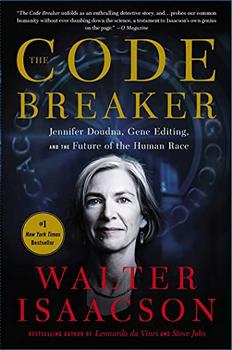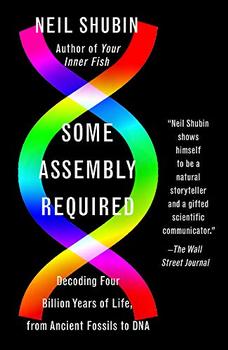Summary | Excerpt | Reviews | Beyond the book | Read-Alikes | Genres & Themes | Author Bio

Jennifer Doudna, Gene Editing, and the Future of the Human Race
by Walter Isaacson Voted 2021 Best Nonfiction Award Winner by BookBrowse Subscribers
What makes humans human? It's a mystery that has inspired philosophers and driven scientific endeavor. The discovery of DNA in the 1950s provided a giant leap forward in answering that question, and today's genetic researchers continue to explore it. Concurrently, they are also learning how to potentially edit or improve a human's basic genetic makeup.
It is through gene editing and discovering the means of how humans could potentially alter themselves at the basic genetic level that The Code Breaker introduces the reader to some of the most updated advancements. Biographer Walter Isaacson describes the quest that begins with the discovery of DNA and ends with the winner of the 2020 Nobel Prize in Chemistry, Jennifer Doudna (who shared the prize with her French colleague, Emmanuelle Charpentier). In particular, the Nobel Committee recognized their work with a CRISPR associated enzyme (Cas9) that can change genetic information.
DNA contains the genetic instructions for living organisms. As its role became clearer, scientists speculated about the possibility of "editing" DNA to open up incredible opportunities — such as genetically modifying crops and animals to make them more productive and resistant to diseases and pests, and potentially to treat genetic conditions in humans, such as sickle-cell anemia and blindness. But how to achieve this? Several approaches were investigated, but the discovery of a naturally occurring gene editing system in bacteria led to the identification of the protein CRISPR-Cas9, which proved to be the key. Faster, cheaper, more accurate, and more efficient than other genome editing methods, CRISPR-Cas9 is revolutionizing — and turbocharging — research, giving scientists their first practical tool for gene editing.
Isaacson narrates Jennifer Doudna's life, beginning with her upbringing in Hawaii and the inspiration she found in Dr. James Watson's book The Double Helix, an autobiographical narrative of the author's discovery of the structure of DNA. Driven to succeed in science, Doudna rose in her field to eventually become a leader in genetic research. Isaacson covers in detail how she collaborated with other scientists to make the advances that led to the discovery of CaS9. However, this book is as much a history of genetic research as it is a biography of Doudna. Along with offering accessible explanations of what Doudna and her peers discovered and developed, this work also explores some of the less commonly discussed aspects of modern science: the struggle to get money for research, the friction between the objectives of academic research (advancements in science) and the objectives of the private sector (scientific discovery for profit), the arduous process to get discoveries published and patented, and the in-fighting between scientists.
These aspects can be the most engaging for the non-scientific reader. No sooner did Doudna and her team publish their results in 2012 when another scientist, Feng Zhang, made his claim to being the rightful discoverer of CRISPR (see Beyond the Book). The years-long battle between these two, along with various other stakeholders in genetic editing, takes the reader from learning about science to patent law and litigation.
The Code Breaker also considers the ethical angle of this discovery. While Issacson notes that the CRIPSR-inspired advancements can help those with sickle-cell anemia, he also describes how one Chinese scientist used this technology to conceive genetically modified babies. As humans learn what they can do with gene editing, there is the equally important challenge of learning what we must not do.
The last portion of the book examines how Doudna and her peers turned their research attention to COVID-19. The lessons learned from the discovery of CaS9 and gene editing played a major role in scientists' efforts to understand the new coronavirus and to develop the vaccines to suppress it. While this section can feel like an afterthought, its relevance given the significant impact COVID-19 has had on the world cannot be discounted.
Overall, this is an outstanding combination of biography, current events and science writing all in one volume. Being an Isaacson work, there is a lot of material to get through, but it is incredibly readable and engaging. The visual aids (including a graphic that describes exactly how CRISPR works) are especially insightful. While it is a substantial book, The Code Breaker is worth the time investment.
![]() This review was originally published in The BookBrowse Review in May 2021, and has been updated for the
May 2022 edition.
Click here to go to this issue.
This review was originally published in The BookBrowse Review in May 2021, and has been updated for the
May 2022 edition.
Click here to go to this issue.

If you liked The Code Breaker, try these:

by Thomas Levenson
Published 2025
The centuries-long quest to discover the critical role of germs in disease reveals as much about human reasoning—and the pitfalls of ego—as it does about microbes.

by Neil Shubin
Published 2021
The author of the best-selling Your Inner Fish gives us a lively and accessible account of the great transformations in the history of life on Earth--a new view of the evolution of human and animal life that explains how the incredible diversity of life on our planet came to be.
Your guide toexceptional books
BookBrowse seeks out and recommends the best in contemporary fiction and nonfiction—books that not only engage and entertain but also deepen our understanding of ourselves and the world around us.